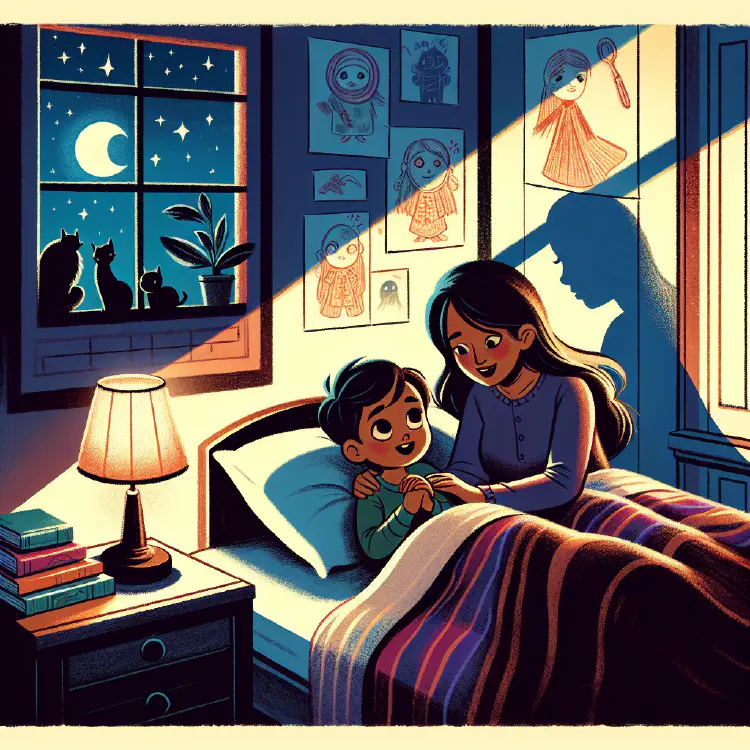How Storytelling Can Help with Nighttime Fears
Storytelling at bedtime can alleviate children's nighttime fears by providing distraction, emotional regulation, bonding, and creating positive associations with sleep.
- 4 min read

As parents, we all know the struggle of putting our little ones to bed, especially when they’re plagued by nighttime fears. Whether it’s monsters under the bed, shadows on the wall, or simply the dark itself, these fears can make bedtime a challenging and stressful experience for both children and parents. But what if there was a simple, enjoyable solution that could help ease these fears and make bedtime a more positive experience? Enter the power of storytelling.
Bedtime stories have been a cherished tradition for generations, and for good reason. Not only do they provide a special bonding time between parent and child, but they also offer numerous benefits that can help alleviate nighttime fears and promote better sleep. In this blog post, we’ll explore how storytelling can be a powerful tool in combating bedtime anxieties and creating a peaceful nighttime routine for your little ones.
The Psychology Behind Nighttime Fears
Before we dive into how storytelling can help, it’s important to understand why children experience nighttime fears in the first place. These fears are a normal part of childhood development and often stem from a child’s growing imagination and understanding of the world around them.
As children’s cognitive abilities develop, they become more aware of potential dangers and uncertainties in their environment. This newfound awareness, combined with the darkness and quiet of nighttime, can lead to increased anxiety and fear. Common nighttime fears include:
- Fear of the dark
- Monsters or other imaginary creatures
- Separation anxiety
- Fear of intruders or burglars
- Worries about natural disasters or other real-world dangers
While these fears are normal, they can significantly impact a child’s sleep quality and overall well-being. This is where the power of storytelling comes into play.
The Benefits of Bedtime Stories
Bedtime stories offer a multitude of benefits that can help address nighttime fears and create a more positive bedtime experience. Here are some of the key advantages of incorporating storytelling into your child’s nighttime routine:
Distraction from fears: Engaging in a story can help shift your child’s focus away from their fears and onto something more positive and enjoyable.
Emotional regulation: Stories can help children process and understand their emotions, including fear and anxiety.
Bonding time: Reading bedtime stories together creates a special connection between parent and child, fostering a sense of security and comfort.
Cognitive development: Regular exposure to stories can improve language skills, vocabulary, and imagination.
Relaxation: The act of listening to a story can be calming and help prepare the mind and body for sleep.
Positive associations: Over time, bedtime stories can help create positive associations with bedtime, making it a more enjoyable experience for children.
How Storytelling Addresses Nighttime Fears
Now that we understand the benefits of bedtime stories, let’s explore how storytelling can specifically address and alleviate nighttime fears:
- Providing a sense of control
One of the reasons children experience fear at night is a lack of control over their environment. Storytelling can help address this by allowing children to become active participants in the narrative. Encourage your child to choose the story, ask questions, or even contribute to the plot. This involvement gives them a sense of control and empowerment, which can help reduce feelings of helplessness associated with their fears.
- Offering alternative perspectives
Bedtime stories for preschoolers and toddlers often feature characters who overcome challenges or face their fears. These narratives can provide children with alternative perspectives on their own fears and anxieties. By relating to characters in the story, children can learn new coping strategies and gain confidence in their ability to face their own fears.
- Creating a safe space for exploration
Stories provide a safe, imaginative space where children can explore and process their fears without feeling overwhelmed. Through the characters and situations in the story, children can indirectly confront their anxieties and work through them in a non-threatening way.
- Establishing a consistent routine
Consistency is key when it comes to addressing nighttime fears. Incorporating bedtime stories into your nightly routine can create a sense of predictability and stability, which can be comforting for children who are feeling anxious or scared.
- Promoting relaxation and mindfulness
The act of listening to a story can be inherently relaxing, helping to calm an anxious mind. Some sleep stories are specifically designed to promote relaxation and mindfulness, using soot
